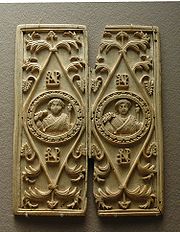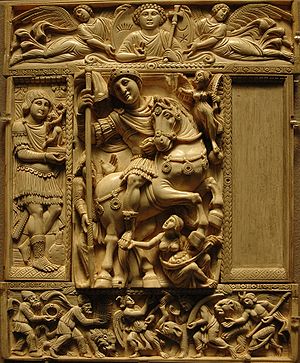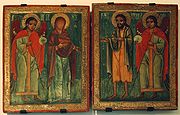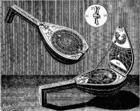
Diptych
Encyclopedia


Hinge
A hinge is a type of bearing that connects two solid objects, typically allowing only a limited angle of rotation between them. Two objects connected by an ideal hinge rotate relative to each other about a fixed axis of rotation. Hinges may be made of flexible material or of moving components...
. Devices of this form were quite popular in the ancient world, wax tablet
Wax tablet
A wax tablet is a tablet made of wood and covered with a layer of wax, often linked loosely to a cover tablet, as a "double-leaved" diptych. It was used as a reusable and portable writing surface in Antiquity and throughout the Middle Ages...
s being coated with wax on inner faces, for recording notes and for measuring time and direction.
In Late Antiquity
Late Antiquity
Late Antiquity is a periodization used by historians to describe the time of transition from Classical Antiquity to the Middle Ages, in both mainland Europe and the Mediterranean world. Precise boundaries for the period are a matter of debate, but noted historian of the period Peter Brown proposed...
, ivory diptychs with covers carved in low relief on the outer faces were a significant art-form: the "consular diptych
Consular diptych
In Late Antiquity a consular diptych was a particular type of diptych which could function as a writing tablet but was also intended as a deluxe commemorative object, commissioned by a consul ordinarius and then distributed to reward those who had supported his candidature as...
" was made to celebrate an individual's becoming Roman consul
Roman consul
A consul served in the highest elected political office of the Roman Republic.Each year, two consuls were elected together, to serve for a one-year term. Each consul was given veto power over his colleague and the officials would alternate each month...
, but some, perhaps including the Poet and Muse diptych
Poet and Muse diptych
The Poet and Muse diptych is a Late Antique ivory diptych that appears to commemorate, and to flatter, the literary pursuits of the aristocrat who commissioned it, so that it stands somewhat apart from the consular diptychs that were carved for distribution to friends and patrons when a man assumed...
at Monza
Monza
Monza is a city and comune on the river Lambro, a tributary of the Po, in the Lombardy region of Italy some 15 km north-northeast of Milan. It is the capital of the Province of Monza and Brianza. It is best known for its Grand Prix motor racing circuit, the Autodromo Nazionale Monza.On June...
, may have been made for private use. Some of the most important surviving works of the Late Roman Empire are diptychs, of which some dozens survive, preserved in some instances by being reversed and re-used as book covers. The largest surviving Byzantine ivory panel (428 mm x 143mm), is a leaf from a diptych in the Justinian court manner of ca. 525–50, which features an archangel. From the Middle Ages
Middle Ages
The Middle Ages is a periodization of European history from the 5th century to the 15th century. The Middle Ages follows the fall of the Western Roman Empire in 476 and precedes the Early Modern Era. It is the middle period of a three-period division of Western history: Classic, Medieval and Modern...
many panel painting
Panel painting
A panel painting is a painting made on a flat panel made of wood, either a single piece, or a number of pieces joined together. Until canvas became the more popular support medium in the 16th century, it was the normal form of support for a painting not on a wall or vellum, which was used for...
s took the diptych form, as small portable works for personal use; large altarpiece
Altarpiece
An altarpiece is a picture or relief representing a religious subject and suspended in a frame behind the altar of a church. The altarpiece is often made up of two or more separate panels created using a technique known as panel painting. It is then called a diptych, triptych or polyptych for two,...
s tended to be made in triptych
Triptych
A triptych , from tri-= "three" + ptysso= "to fold") is a work of art which is divided into three sections, or three carved panels which are hinged together and can be folded shut or displayed open. It is therefore a type of polyptych, the term for all multi-panel works...
form, with two outer panels that could be closed across the main central representation. They are one type of the multi-panel forms of painting known as Polyptych
Polyptych
A polyptych generally refers to a painting which is divided into sections, or panels. The terminology that follows is in relevance to the number of panels integrated into a particular piece of work: "diptych" describes a two-part work of art; "triptych" describes a three-part work; "tetraptych"...
s.
The term is also sometimes used figuratively to refer to two thematically-linked books or films.
Ecclesiastical

Christian
A Christian is a person who adheres to Christianity, an Abrahamic, monotheistic religion based on the life and teachings of Jesus of Nazareth as recorded in the Canonical gospels and the letters of the New Testament...
literature is found. The term refers to official lists of the living and departed that are commemorated by the local church. The living would be inscribed on one wing of the diptych, and the departed on the other. The inscribing of a bishop's name in the diptychs means that the local church
Local church
A local church is a Christian congregation of members and clergy.Local church may also refer to:* Local churches , a Christian group based on the teachings of Watchman Nee and Witness Lee, and associated with the Living Stream Ministry publishing house.* Parish church, a local church united with...
considers itself to be in communion with him, the removal of a bishop's name would indicate breaking communion with him. The names in the diptychs would be read publicly by the deacon
Deacon
Deacon is a ministry in the Christian Church that is generally associated with service of some kind, but which varies among theological and denominational traditions...
during the Divine Liturgy
Divine Liturgy
Divine Liturgy is the common term for the Eucharistic service of the Byzantine tradition of Christian liturgy. As such, it is used in the Eastern Orthodox and Eastern Catholic Churches. Armenian Christians, both of the Armenian Apostolic Church and of the Armenian Catholic Church, use the same term...
(Eucharist
Eucharist
The Eucharist , also called Holy Communion, the Sacrament of the Altar, the Blessed Sacrament, the Lord's Supper, and other names, is a Christian sacrament or ordinance...
), and by the priest during the Liturgy of Preparation
Liturgy of Preparation
The Liturgy of Preparation, also Prothesis or Proskomedia , is the name given in the Eastern Orthodox Church and the Byzantine-rite Eastern Catholic Churches to the act of preparing the bread and wine for the Eucharist...
. Diptychs were also used to inscribe the names of the saints. Although the wax tablets themselves are no longer used, the term is still used in the Eastern Orthodox Church
Eastern Orthodox Church
The Orthodox Church, officially called the Orthodox Catholic Church and commonly referred to as the Eastern Orthodox Church, is the second largest Christian denomination in the world, with an estimated 300 million adherents mainly in the countries of Belarus, Bulgaria, Cyprus, Georgia, Greece,...
and Eastern Catholic Churches to describe the contents of the diptychs, with all the same connotations.
A diptych is also a type of icon
Icon
An icon is a religious work of art, most commonly a painting, from Eastern Christianity and in certain Eastern Catholic churches...
whereby two panels are joined together with a hinge, so that they may fold together for protection when travelling, and then be unfolded for veneration
Veneration
Veneration , or veneration of saints, is a special act of honoring a saint: an angel, or a dead person who has been identified by a church committee as singular in the traditions of the religion. It is practiced by the Eastern Orthodox Church, the Roman Catholic, and Eastern Catholic Churches...
when one's destination has been reached. Such diptychs are also called "travelling icons". Often the subjects on the two panels will be a matched set, such as Christ and the Theotokos
Theotokos
Theotokos is the Greek title of Mary, the mother of Jesus used especially in the Eastern Orthodox, Oriental Orthodox, and Eastern Catholic Churches. Its literal English translations include God-bearer and the one who gives birth to God. Less literal translations include Mother of God...
, or the Annunciation
Annunciation
The Annunciation, also referred to as the Annunciation to the Blessed Virgin Mary or Annunciation of the Lord, is the Christian celebration of the announcement by the angel Gabriel to Virgin Mary, that she would conceive and become the mother of Jesus the Son of God. Gabriel told Mary to name her...
(with the Archangel
Archangel
An archangel is an angel of high rank. Archangels are found in a number of religious traditions, including Judaism, Christianity and Islam. Michael and Gabriel are recognized as archangels in Judaism and by most Christians. Michael is the only archangel specifically named in the Protestant Bible...
Gabriel
Gabriel
In Abrahamic religions, Gabriel is an Archangel who typically serves as a messenger to humans from God.He first appears in the Book of Daniel, delivering explanations of Daniel's visions. In the Gospel of Luke Gabriel foretells the births of both John the Baptist and of Jesus...
on one side and the Virgin Mary on the other), or Saints Peter and Paul.
Diptych sundial

Gnomon
The gnomon is the part of a sundial that casts the shadow. Gnomon is an ancient Greek word meaning "indicator", "one who discerns," or "that which reveals."It has come to be used for a variety of purposes in mathematics and other fields....
was a string between them, and calibrated as to how far they should open, as the angle is critical. Such a sundial can be adjusted to any latitude by tilting it so its gnomon is parallel to the Earth's axis of rotation. A common error states that if both dials show the same time, the instrument is oriented correctly and faces north (in the northern hemisphere). A Diptych made as stated as a combined vertical and horizontal sundial with a string gnomon will show the same time on both dials regardless of orientation. This property of self alignment is only true for diptychs historically in the case for a combination of an analemmatic and a vertical sundial. A double dial on a flat plate consisting of a horizontal and an analemmatic dial will also be aligned properly if both dials show the same time.
Some diptychs had rough calendars, in the form of pelekinons calibrated to a nodus in the form of a bead or knot on the string. These are accurate to about a week, which was good enough to time planting of crops.
Writing tablet
The more common form of diptych in Antiquity was like a shallow box. It had two wooden leaves with hollows on the inside edges, filled with waxWax
thumb|right|[[Cetyl palmitate]], a typical wax ester.Wax refers to a class of chemical compounds that are plastic near ambient temperatures. Characteristically, they melt above 45 °C to give a low viscosity liquid. Waxes are insoluble in water but soluble in organic, nonpolar solvents...
, and space for a small wooden scriber
Scriber
A scriber is a hand tool used in metalworking to mark lines on workpieces, prior to machining. The process of using a scriber is called scribing and is just part of the process of marking out. It is used instead of pencils or ink lines, because the marks are hard to see, easily erased, and...
. This permitted one to take waterproof notes in the wax without wasting money on paper. The wax could be smoothed and reused.
In later art
The diptych was a common format in Early Netherlandish paintingEarly Netherlandish painting
Early Netherlandish painting refers to the work of artists active in the Low Countries during the 15th- and early 16th-century Northern renaissance, especially in the flourishing Burgundian cities of Bruges and Ghent...
and depicted subjects ranging from secular portraiture to religious personages and stories. Often a portrait and a Madonna and Child had a leaf each. It was especially popular in the 15th and 16th centuries. Painters such as Jan van Eyck
Jan van Eyck
Jan van Eyck was a Flemish painter active in Bruges and considered one of the best Northern European painters of the 15th century....
, Rogier van der Weyden, Hans Memling
Hans Memling
Hans Memling was a German-born Early Netherlandish painter.-Life and works:Born in Seligenstadt, near Frankfurt in the Middle Rhein region, it is believed that Memling served his apprenticeship at Mainz or Cologne, and later worked in the Netherlands under Rogier van der Weyden...
and Hugo van der Goes
Hugo van der Goes
Hugo van der Goes was a Flemish painter. He was, along with Jan van Eyck, Rogier van der Weyden, Hans Memling and Gerard David, one of the most important of the Early Netherlandish painters.-Biography:...
used the form. Some modern artists have used the term in the title of works consisting of two paintings never actually connected, but intended to be hung close together as a pair, such as Andy Warhol
Andy Warhol
Andrew Warhola , known as Andy Warhol, was an American painter, printmaker, and filmmaker who was a leading figure in the visual art movement known as pop art...
’s Marilyn Diptych
Marilyn Diptych
The Marilyn Diptych is a silkscreen painting by American pop artist Andy Warhol.-History and analysis:The work was completed during the weeks after Marilyn Monroe's death in August 1962...
(1962) is a modern pop culture icon.
See also
- Symmachi–Nicomachi diptychSymmachi–Nicomachi diptychThe Symmachi–Nicomachi diptych is a Late Antique ivory diptych dating to the late fourth or early fifth century whose panels depict scenes of ritual pagan religious practices...
a Late Antique ivory diptych celebrating a marriage alliance.
External links
- National Gallery of Art, Prayers and Portraits: Unfolding the Netherlandish Diptych
- Diptych The Catholic Encyclopedia, Volume V, Robert Appleton Company, Online Edition.
- Diptych sundials, National Maritime Museum.

